
table of contents
- Thistles
- Types from A - E
- Types from F - J
- Types of K - R
- Types from S - Z
- frequently asked Questions
If you look closely at a thistle, you will quickly recognize the extraordinary beauty of this plant species. The gardening trade has a selection of decorative thistle varieties ready for you. We present the most beautiful varieties.
In a nutshell
- prickly plants of various genera are called thistles
- valuable nutrient plants for birds, bees, bumblebees and flower-visiting insects
- suitable for dry floristry
- undemanding, perfect for beginners
- thrive on poor soils in sunny locations
Thistles
Thistles are usually referred to as plants covered with thorns and thorns. It is not a special botanical genus. The bizarre beauties are very different in size, appearance and lifespan. Among them are low ground covers, as well as plants that can reach three meters in height. On a hike through nature, one can encounter thistles in forests as well as on dry grass areas and on the edges of fields. They are an important source of food for insects, birds and small animals.
If you spot a wild thistle in your garden, don't remove it immediately like ordinary weeds. Some species of thistle are endangered. Turn a corner in your garden into a natural garden. Lure bees and bumblebees with the prickly flowering plants and look forward to a high-yielding fruit and vegetable harvest. Decorative precious thistles are also available for cultivation in the garden.
Types from A - E
Banat Globe thistle (Echinops bannaticus)

- Height: 80 to 120 centimeters
- Flowers: round, light blue
- Flowering period: August to September
- Leaves: gray-green, firm, pinnate, hairy underside of leaves
- Location: sunny
- Soil: dry to moist, well-drained, loamy
- Lifespan: several years
- Winter hardiness: yes
- Care: cut back in autumn
- Use: bed background, dry floristry
Note: A ball thistle is not just an eye-catcher in the bed. It magically attracts flower-visiting insects. There is hardly a blossom on the thistle that is not occupied by a bee, a bumblebee or a butterfly in sunny weather.
Blue globe thistle (Echinops ritro)

- Height: 60 to 100 centimeters
- Flowers: round, light blue to purple with blue pollen
- Flowering period: August to September
- Leaves: firm, silvery, pinnate
- Location: sunny
- Soil: dry to moist, well-drained, normal garden soil
- Lifespan: several years
- Winter hardiness: yes
- Care: remove dead flowers regularly
- Use: bee pasture
Ivory thistle (Eryngium giganteum)
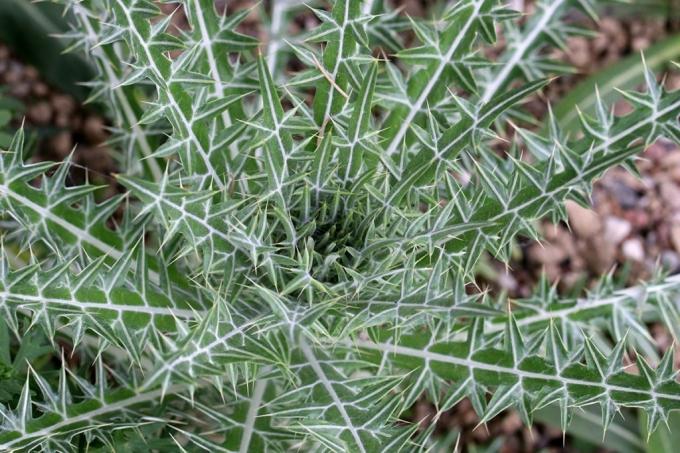
- Height: 40 to 80 centimeters
- Flowers: white, ovate inflorescence with silvery bracts
- Flowering period: July to August
- Leaves: green with white veins, heart-shaped, pointed
- Location: sunny
- Soil: dry to fresh, humic, sandy to loamy, well-drained
- Lifespan: every two years
- Winter hardiness: yes
- Care: remove dead flowers regularly
- Use: dry floristry, bee pasture, works wonderfully in the bed in combination with blue flowering perennials
Note: The ivory thistle sows itself. If you want to multiply the plant, you should consider its membership of the cold germs. Plants in this category need a cold stimulus for germination to begin.
Elf thistle (Morina longifolia)
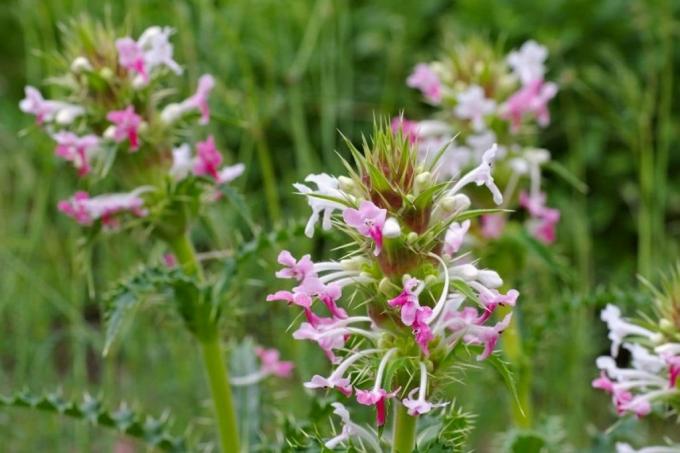
- Height: 60 to 80 centimeters
- Flowers: initially white, spike-shaped, later pink, spiny bracts, fragrant
- Flowering period: July to August
- Leaves: green, elongated, pinnate, serrated, aromatic
- Location: full sun
- Soil: poor in nutrients, calcareous, well-drained
- Lifespan: every two years
- Winter hardiness: yes
- Care: remove dead flowers regularly
- Use: rock garden plant, dry flora, bee pasture, naturopathy
Note: The elf thistle is also known under the name "Persian steppe thistle" or "card thistle".
Types from F - J
Flat leafLoyal to men (Eryngium planum)
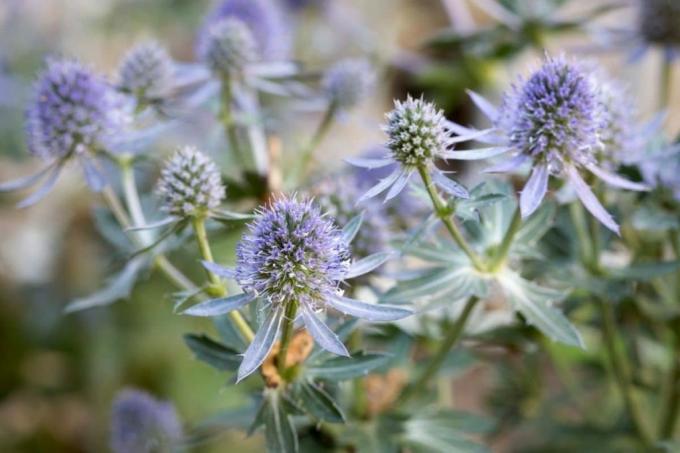
- Height: 40 to 80 centimeters
- Flowers: blue, spherical inflorescence with narrow bracts
- Flowering period: August to October
- Leaves: gray-green, spatulate, toothed, thorny
- Location: sunny
- Soil: dry to fresh, well-drained
- Lifespan: several years
- Winter hardiness: yes
- Care: pruning back withered flowers
- Use: cut flowers, dry flowers
Note: Do not cut flat-leaf man litter in the fall. In winter, when covered with hoar frost, the plant is an ornament in the garden.
Common donkey thistle (Onopordum acanthium)
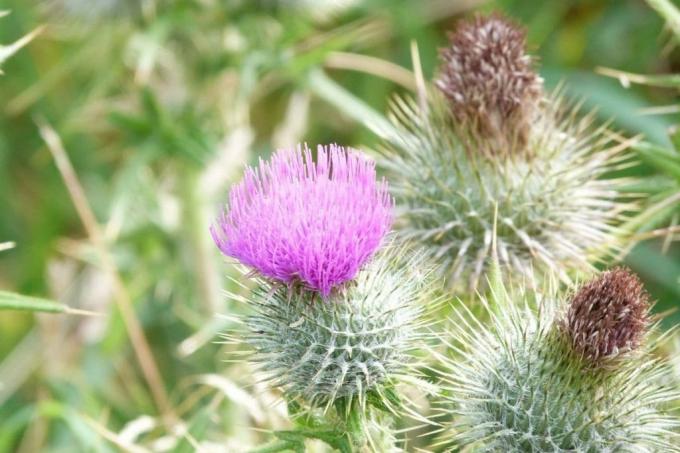
- Height: 150 to 300 centimeters
- Flowers: purple tubular flowers, surrounded by silvery white bracts
- Flowering period: July to August
- Leaves: silvery white, frosted, pointed, incised, typical of a thistle
- Location: sunny to partially shaded
- Soil: dry, well-drained, sandy, poor in nutrients
- Lifespan: every two years
- Winter hardiness: yes
- Care: support large plants with stakes
- Use: bee pasture, bird seed
Note: The donkey thistle spreads strongly by self-sowing. Cut off the almost ripe seed heads before they fall out and spread by themselves. Offer this to the birds as a valuable source of food in winter.
Common golden thistle (Carlina vulgaris)

- Height: 10 to 30 centimeters
- Flowers: light yellow bracts, in the middle yellow tubular flowers with purple tips
- Flowering period: July to September
- Leaves: green, curled, toothed
- Location: sunny to partially shaded
- Soil: poor in nutrients, neutral to lime-rich, well-drained
- Lifespan: every two years
- Winter hardiness: yes
- Care: undemanding
- Use: Design of natural gardens, bee pastures, dry floristry
Types of K - R
Curly-leaved silver thistle (Carlina acaulis)
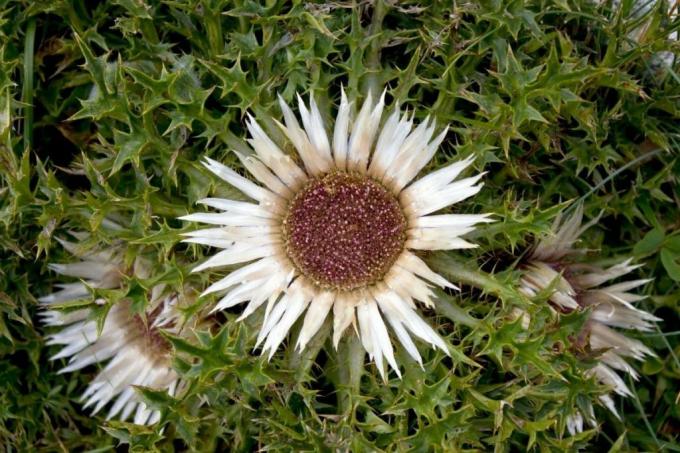
- Height: 10 to 20 centimeters
- Flowers: large, silvery-white with a dark center, bowl-shaped, very stable
- Flowering period: July to September
- Leaves: pointed, incised, typical of thistles
- Location: sunny to partially shaded
- Soil: dry, well-drained, sandy, poor in nutrients
- Lifespan: several years
- Winter hardiness: yes
- Care: undemanding
- Use: rock garden plant, perfect for creating dry flowers
Note: The silver thistle can indicate the weather. Plant a copy in your front yard. When the humidity rises and the likelihood of rain increases, it closes its flowers. Then you should pack an umbrella!
Purple thistle (Cirsium rivulare)
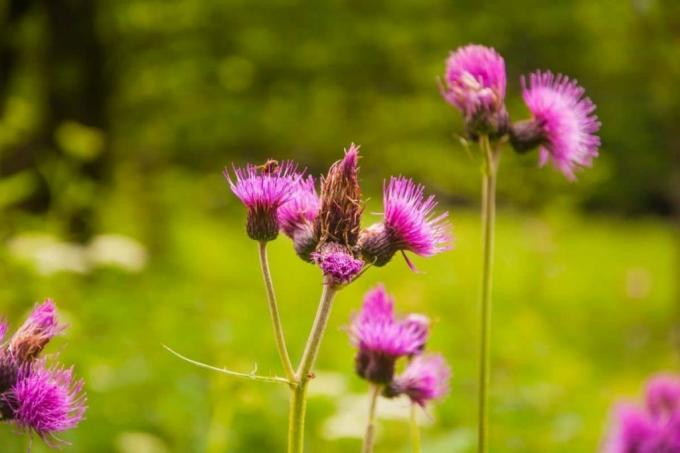
- Height: 70 to 120 centimeters
- Flowers: purple-red
- Flowering period: June to August
- Leaves: gray-green, heart-shaped, toothed, thorny
- Location: sunny, near the water
- Soil: moist, humic, low in lime, well drained
- Lifespan: several years
- Winter hardiness: yes
- Care: remove dead flowers regularly
- Use: cut flower, bee pasture
Types from S - Z
Stemless thistle (Cirsium acaule)

- Height: 10 to 15 centimeters
- Flowers: pink to pale purple, feathery
- Flowering period: July to August
- Leaves: green, hairy white on the underside, thorny tips, arranged in rosettes
- Location: sunny to partially shaded
- Soil: poor in nutrients, calcareous, stony, well-drained
- Lifespan: several years
- Winter hardiness: yes
- Care: remove dead flowers regularly
- Use: Design of stone and natural gardens, attracts bumblebees
Sea thistle (Eryngium maritimum)

- Height: 30 to 60 centimeters
- Flowers: gray-white, spherical inflorescence framed by spiky petals
- Flowering period: June to October
- Leaves: gray-green, smooth, thorny
- Location: sunny to partially shaded
- Soil: poor in nutrients, neutral to lime-rich, sandy, well-drained
- Lifespan: every two years
- Winter hardiness: yes
- Care: undemanding
- Use: design of natural gardens, attracts butterflies and insects
Note: The sea thistle is on the Red List of Endangered Species. Give it a place in the garden and help preserve the magical thistle. It is also known as sailor litter or sea root.
South African purple thistle (Berkheya purpurea)
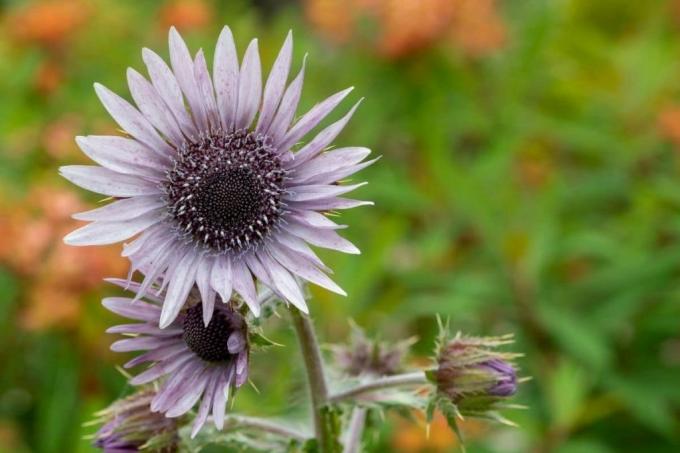
- Height: 50 to 70 centimeters
- Flowers: light purple, resembles a margarite
- Flowering period: July to September
- Leaves: silvery, prickly, serrated
- Location: sunny
- Soil: dry, calcareous, well-drained
- Lifespan: one year
- Winter hardiness: no
- Care: undemanding
- Use: rock garden plant, cut flower, dry floristry
White globe thistle (Echinops spherocephalus)
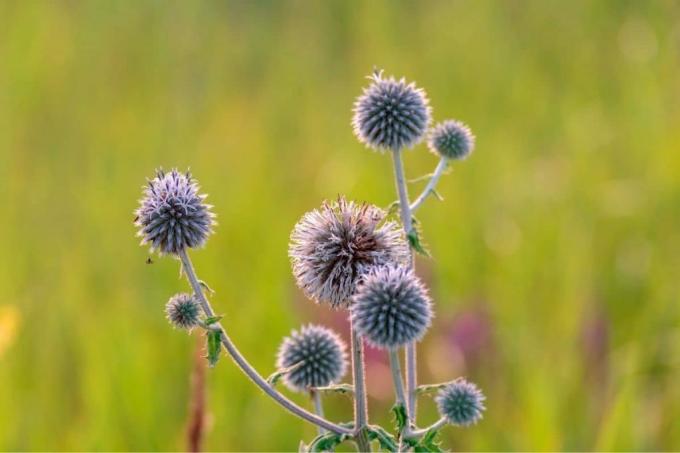
- Height: 80 to 100 centimeters
- Flowers: round, white
- Flowering period: July to September
- Leaves: firm, silvery green, stems reddish
- Location: sunny
- Soil: dry to moist, well-drained, loamy
- Lifespan: several years
- Winter hardiness: yes
- Care: cut back in autumn
- Use: Structure formation in perennial beds, dry floristry
Note: The generic name "Echinops" contains the Latin words Echinus (hedgehog) and opsis (similar). The spherical flowers appear like small curled up hedgehogs.
frequently asked Questions
The thistle is a very robust plant. It is rarely attacked by pests. Even snails avoid them. Occasionally, aphids appear. Moisture in winter can cause root rot. For this reason, we recommend covering perennial species with brushwood.
The thistle is a real dry artist. It survives even hot summers in Central European regions without additional watering.
Most species reproduce by self-sowing. The delicate seed heads are spread by the wind. Globular thistles can be propagated in spring by dividing them.
Especially noble thistles and spherical thistles can be cultivated excellently in the tub on the balcony or terrace. They form long tap roots. Thistles therefore need a tall vessel for pail culture.


